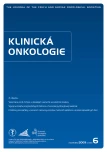Lifestyle of Cancer Patients – How and When to Change it?
Authors:
D. Hrubá; H. Matějová
Authors‘ workplace:
Ústav preventivního lékařství LF MU Brno
Published in:
Klin Onkol 2009; 22(6): 291-293
Category:
Short Communication
Overview
The increase in the rate of cancer survivors following diagnosis and treatment of malignant tumours is one of the most important successes in modern medicine. There is also increasing interest from specialists in how lifestyle changes contribute to this beneficial trend. The intervention is focused namely on nutrition, physical activity and smoking. The effects of intervention may be influenced by the optimal timing of patients’ motivation to adopt such changes.
Key words:
cancer – patient – lifestyle – motivation
Sources
1. Hooning MJ, Aleman BM, van Rosmalen AJ et al. Cause ‑ specific mortality in long‑term survivors of breast cancer: a 25‑year follow‑up study. Int J Radiat Oncol Biol Phys 2006; 64 : 1081 – 1091.
2. Blanchart CM, Courneya KS, Stein K. Cancer survivors’ adherence to lifestyle behavior recommendations and associations with health‑related quality of life: results from the American Cances Society’s SCS ‑ II. J Clin Oncol 2008; 26 : 2198 – 2204.
3. Bellizzi KM, Rowland JH, Jeffery DD et al. Health behaviors of cancer survivors: examining opportunities for cancer control intervention. J Clin Oncol 2005; 23 : 8884 – 8893.
4. Rock CL, Demark ‑ Wahnefried W. Nitrition and survival after the diagnosis of breast cancer: a review of the evidence. J Clin Oncol 2002; 20 : 3302 – 3316.
5. Pierce JP, Natarajan I, Caan BJ et al. Influence of a diet very high in vegetables, fruit, and fiber and low in fat on prognosis following treatment for breast cancer: the women Healthy Eating and Living (WHEL) randomized trial. JAMA 2007; 298 : 289 – 298.
6. Maunsell E, Drolet M, Brisson J et al. Dietary change after breast cancer: extent, predictors, and relation with psychological distress. J Clin Oncol 2002; 20 : 1017 – 1025.
7. McBride CM, Clipp E, Peterson BI et al. Psychological impact of diagnosis and risk reduction among cancer survivors. Psychooncology 2000; 9 : 418 – 427.
8. Courneya KS, Friedenreich CM. Physical exercise and quality of life following cancer diagnosis: a literature review. Ann Behav Med 1999; 21 : 171 – 179.
9. Dimeo F, Fetscher S, Lange W et al. Effects of aerobic exercise on the physical performance and incidence of treatment‑related complications after high‑dose chemotherapy. Blood 1997; 90 : 3390 – 3394.
10. Segal R, Evans W, Johnson D et al. Structural exercise improves physical functioning in women with stages I and II breast cancer: results of a randomized controlled trial. J Clin Oncol 2001; 19 : 657 – 665.
11. Gritz ER, Fingeret MC, Vidrine DJ et al. Successes and failures of the teachable moment: smoking cessation in cancer patients. Cancer 2006; 106 : 17 – 27.
12. Humpel N, Magee C, Jones SC. The impact of a cancer diagnosis on the health behaviors of cancer survivors and their family and friends. Support Care Cancer 2007; 15 : 621 – 630.
13. McBride CM, Emmons KM, Lipkus IM. Understanding the potential of teachable moments: the case of smoking cessation. Health Educ Res 2003; 18 : 156 – 170.
14. Partridge A, Adolf K, Blood E et al. Risk perceptions and psychosocial outcomes of women with ductal carcinoma in situ: Longitudinal results from a cohort study. J Natl Cancer Inst 2008; 100 : 243 – 251.
15. Rabin C, Pinto B. Cancer‑related beliefs and health behavior change among breast cancer survivors and their first ‑ degree relatives. Psychooncology 2005; 15 : 701 – 712.
16. Calvao DA, Newton RU. Review of exercise intervention studies in cancer patients. J Clin Oncol 2005; 23 : 899 – 909.
17. Knols R, Aaronson NK, Uebelhart D et al. Physical exercise in cancer patients during and after medical treatment: a systematic review of randomized and controlled clinical trials. J Clin Oncol 2005; 23 : 3830 – 3842.
18. Pinto BM, Eakin E, Maruyama NV. Health behavior changes after a cancer diagnosis: what do we know and where do we go from here? Ann Behav Med 2000; 22 : 38 – 52.
19. Park CL, Gaffey AE. Relationships between psychosocial factors and health behavior change in cancer survivors: an integrative review. Ann Behav Med 2007; 34 : 115 – 134.
Labels
Paediatric clinical oncology Surgery Clinical oncologyArticle was published in
Clinical Oncology

2009 Issue 6
- Metamizole at a Glance and in Practice – Effective Non-Opioid Analgesic for All Ages
- Possibilities of Using Metamizole in the Treatment of Acute Primary Headaches
- Metamizole in perioperative treatment in children under 14 years – results of a questionnaire survey from practice
- Obstacle Called Vasospasm: Which Solution Is Most Effective in Microsurgery and How to Pharmacologically Assist It?
- Metamizole vs. Tramadol in Postoperative Analgesia
Most read in this issue
- Neo‑Adjuvant Chemotherapy Followed by Interval Debulking Surgery in Advanced Ovarian Cancer Treatment – a Retrospective Study
- Aromatase Inhibitors in Risk Reduction of Breast Cancer: Potential Use in Premenopausal Women
- Influenza Vaccination for Adult Patients with Solid Malignancies
- Familliar Colorectal Cancer Surveillance
